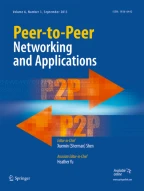Abstract
This paper presents and evaluates router architectures for security networks. Through extensive simulations, the DAMQWR and PD-CB router architecture is shown to best support true fully adaptive routing capability of deadlock recovery schemes while maximizing network performance (102 % higher throughput and 86 % lower network latency than other architectures). Therefore, this router architecture can build a more stable security network by providing a higher network performance.
Similar content being viewed by others
References
Song YH, Pinkston TM (2001) Efficient handling of message-dependent deadlock. 15th IEEE Parallel and Distributed Processing Symposium, IEEE Computer Society
Ho WH, Pinkston TM (2006) A design methodology for efficient application-specific on-chip interconnects. IEEE Transactions on Parallel Distributed System 17(2):174–190
Liu J, Delgado-Frias JG (2007) A DAMQ shared buffer scheme for network-on-chip. In Proceedings of the 5th IASTED International Conference, pp 53-58
Choi Y, Pinkston TM (2004) Evaluation of queue designs for true fully adaptive routers. J Parallel Distrib Comput 64:606–616
Choi Y, Pinkston TM (2001) Evaluation of crossbar architectures for deadlock recovery routers. J Parallel Distrib Comput 61(1):49–78
Pinkston TM, Choi Y (1997) Mongkol Raksapatcharawong. Architecture and optoelectronic implementation of the WARRP router, Proceedings of the 5th Symposium on Hot Interconnects, IEEE Computer Society, Silver Spring, MD, August, pp 181–189
SMART Interconnects Group. Flexsim 1.2 Simulator, University of Southern California; www.usc.edu/dept/ceng/pinkston/SMART.html
Acknowledgment
This paper was supported by Konkuk University in 2009.
Author information
Authors and Affiliations
Corresponding author
Rights and permissions
About this article
Cite this article
Choi, Y., Kim, LK., Ahn, H. et al. Router architecture evaluation for security network. Peer-to-Peer Netw. Appl. 7, 628–635 (2014). https://doi.org/10.1007/s12083-012-0181-3
Received:
Accepted:
Published:
Issue Date:
DOI: https://doi.org/10.1007/s12083-012-0181-3
